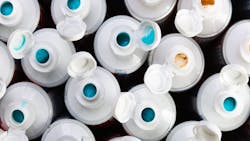Surprising results from a study on post-brushing routines and fluoride retention
A study recently published in BMC Oral Health compared salivary fluoride concentrations among adults in both rinsing and nonrinsing groups.
In the authors’ review of the literature, the post-brushing rinsing was well-studied, but there were no high-quality studies “to support the comparative effectiveness of one active fluoride toothpaste formula over another, with or without post-brushing mouth rinsing.”1
A quick look at the results
- For sodium fluoride, the most commonly used toothpaste fluoride formulation in the United States, there was no statistically significant difference between the rinsing and nonrinsing group, except for at one minute post brushing.
- Sodium monofluorophosphate was the most negatively impacted by rinsing postbrushing
- Popular US brands using sodium monofluorophosphate include Colgate Optic White and Parodontax
- Amine fluoride toothpaste resulted in the highest salivary fluoride concentrations in both the rinsing and nonrinsing groups.
- Toothpastes formulated with amine fluoride are not currently available in the United States
The study tested the following toothpaste formulations:
- Sodium fluoride toothpaste (NaF; 1450 ppmF)
- Sodium monofluorophosphate (NaF and Na2FPO3; 1450 ppmF)
- Sodium fluoride (NaF; 450 ppmF) and monofluorophosphate (Na2FPO3; 1000 ppmF)
- Stannous fluoride (SnF2 and NaF; 1100 ppmF) and sodium fluoride (NaF; 350 ppmF)
- Amine fluoride (AmF; 1400 ppmF)
The control group used a fluoride-free toothpaste.
Surprisingly, rinsing post-brushing did not strongly affect salivary fluoride concentrations, except in the case of sodium monofluorophosphate.
While the study did find a significant difference between rinsing and nonrinsing participants at 1 minute in the sodium fluoride and amine fluoride groups, this difference did not last over time.
The amine fluoride toothpate resulted in “significantly higher salivary fluoride concentration for the longest period (90 min), for both rinsing and nonrinsing groups.”1
Reference
1. Albahrani MM, Alyahya A, Qudeimat MA, Toumba KJ. Salivary fluoride concentration following toothbrushing with and without rinsing: a randomised controlled trial. BMC Oral Health. 2022;22(1):53. Published 2022 Mar 3. doi:10.1186/s12903-022-02086-5
About the Author
Amelia Williamson DeStefano
Group Editorial Director
Amelia Williamson DeStefano, MA, is group editorial director of the Endeavor Business Media Dental Group, where she leads the publication of high-quality content that empowers oral-health professionals to advance patient well-being, succeed in business, and cultivate professional joy and fulfillment. She holds a master's in English Literature from the University of Tulsa and has worked in dental media since 2015.
Updated May 16, 2023

